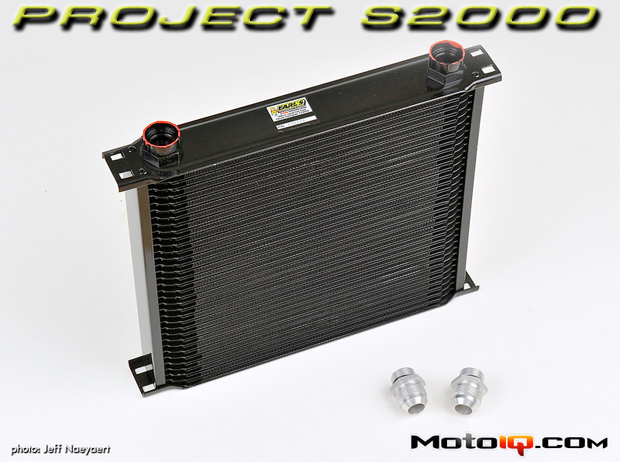,
There are two common approaches to installing an oil cooler on a typical street car. Probably the most common method is mounting it right smack in the middle of the main bumper opening at the very front of the car. I deep-sixed this idea for a number of reasons which I will explain in a bit. The second approach, and usually done on cars designed from the outset with an oil cooler (Evo, Porsche 911, etc), is to mount the oil cooler off to the side of the main opening and in front of one of the front wheels. On the S2000, both the AP1 and AP2 generations have blocked off side openings in the bumper that can be opened up and used to feed air to the oil cooler if the cooler is placed in the side location.
 |
| As I’m adding a big oil cooler, I’m ditching the stock oil-coolant heat exchanger (donut); it serves to warm up the oil faster on cold startup and cool the oil once everything is up to temperature. The coolant typically stays at 90C on the AP2 and the oil at 100C when highway cruising in warm weather with the A/C on. So when the coolant is warmer than the oil, such as when the car is first started up, the oil gets warmed up more quickly which helps reduce fuel consumption. When the oil is hotter than the coolant, the coolant serves to take heat out of the oil. In the place of the stock donut, a Mocal sandwich adapter with a 180F thermostat and -12AN fittings is going in. (EDIT: It turns out Mocal sells a sandwich adapter with a 200F thermostat which is a special order item. I would have prefered the 200F option.) |
 |
| A 30mm socket is required to take off the bolt that holds the stock oil donut. In its place is the shorter stub which is a Honda OEM part. |
I eliminated this idea for three reasons. The first reason is that those openings could be used for brake cooling ducts instead. The second reason, a side mounted oil cooler would require ducting to be fabricated and also the fender liner to be modified to allow an escape path for the air; I’ll admit, I can be lazy and didn’t want to do that much work. The last reason, I wanted the option of using that space for some piping in the future that would go along with a big power upgrade.
 |
| In removing the stock oil donut, I used a pair of vice grips to pinch off the two coolant lines that went to the donut. This allowed me to remove the donut and then drain the coolant in a controlled manner. I have already installed the new stub in this picture. |
Back to the front mounted option. The first issue I ran into on the S2000 was packaging; there’s just too much stuff in the way of where I’d ideally like to mount the oil cooler which limited the possible size. Like I’ve mentioned before, I can be lazy (well, work smarter not harder!). I didn’t want to relocate anything I didn’t have to which involves more work. As this car is my DD, minimal downtime is the goal which means minimal work. I also have limited tools (drill, hammer, dremel, and an angle grinder), so I try to avoid anything requiring more serious fabrication work. Secondly, I wanted some of that space free for something else to go there in looking forward to a possible big power upgrade. Lastly, the flow path of the air and temperatures were taken into account.
On street cars, we typically have an A/C condenser and radiator. Now we’re also throwing in an oil cooler. You typically want the A/C condenser as cool as possible to maximize A/C system performance. The coolant system of the AP2 S2000 tries to maintain a coolant temperature of 90C. A good temperature for oil is around 100C and the stock Honda oil cooler donut keeps it right at that temperature during highway cruising in ~85F temperatures. So, in importance of getting as cool of air as possible, it goes: A/C condenser, radiator, oil cooler. To some companies like GM, maximizing A/C performance is so important that they put the intercooler of the turbo Chevy Cruze BEHIND the A/C condenser! A/C performance takes precedence over engine performance for them.
Let’s look at things another way. If you had the option of overheating your coolant or your oil, which would you choose? The oil of course. Overheating your coolant leads to a blown head gasket pretty quickly whereas most guys that track their cars don’t even know they’re cooking the oil and their cars still make it home.
 |
| The Mocal sandwich adapter installed with the Ark Design adapter for the oil pressure and temperature sensors. The nipples for the coolant hoses are actually about 14mm diameter, but 1/2″ (12.7mm) ID heater hose will slide over without too much trouble. |




17 comments
Why did you choose such a big oil cooler? the aftermarket does not offer such large applications.
Does it have to do with the flow rate of the s2000’s oil pump at high rpm?
I have oil cooler setrab of 18 lines and I see that after 5 minutes on the track the pressure drops to 64psi in vtect and the temperature to 233f
my car is supercharger kraftwerks and the oil cooler is located behind the supercharger intercooler
thanks
Part of the reason was because I put the oil cooler behind all the other heat exchangers, so it was getting the hottest air. Check out the article that is Part 23: Testing air temps through coolers and vents. I also only had one chance to do this setup without testing various combinations, so I went large to be safe. The benefits being more cooling, greater oil capacity, and less pressure drop. I don’t think I’ve ever seen below 75-80psi in the VTEC transition with oil temps at 240F.
my car have kraftwerks kit, please recommend configuration for oil cooler
Use an oil cooler with more rows. The greater number of rows, the lower the pressure drop and the more cooling. Also, what size lines are you using? I’m using -12. Lots of kits use -8 which is too small in my opinion. I would say at least -10.
Why does a greater number of rows equate to a lower drop in oil pressure? Is it because the greater number of rows allows for more paths for the oil to flow and thus less restriction to flow? Also, If I were to take a 30 row oil cooler core and make it into a triple pass where each pass has 10 rows, would that create a pressure drop equivalent to using a 10 row single pass cooler?
Pressure drop is a function of velocity and distance. Pressure drop increases to the square of velocity. And the longer the distance, the greater the pressure drop. So with more rows, you have more flow area, which reduces the velocity for the same mass flow rate.
A 10-row single pass would have less pressure drop than a 30-row triple pass, assuming the cores are the same width. This is because in the 30-row triple pass, the flow distance is triple the 10-row assuming the cores are the same width. And there’s going to be additional pressure drop each time the oil has to make a turn in the triple pass.
Ok that makes sense. Thank you!
what oil use in your car?
Motul 300V 5w-30
I use a line of 16 lines behind the intercooler of my kraftwerks kit and the car easily goes up to 240f.
ask, if I add one of 42 lines behind the radiator with a fan, the temperature will I be able to control it better? What do you recommend doing to keep control of the oil temperature of my car?
The water temperature is stable at 220f
Bigger oil cooler will certainly help. But you also need to address your coolant temps which are too high. Consider that that fans turn on at 212F. Sure, you CAN run at 220F, but it reduces the reliability of your engine and hurts power. My car is naturally aspirated, but coolant never goes over 190F even when I did track days in 103F temps. Make sure you have your heat exchangers well sealed (I used foam stuffed around them) and you certainly need a vented hood if you don’t have one already.
hello I have a question I am using the original car water radiator thermostat, would you recommend changing the sensor to a mishimoto of less temperature? I use the street car too
No, changing to a lower temp thermostat does nothing for reducing temps at steady state conditions. It just delays how quickly the temp will max out.
A friend suggested to me a rather convelling idea about oil cooling: If for example we keep the original donut (oil cooler) to circulate water (circuit with a radiator on the bumper, and an electric pump that activates with a mano connected to the oil temperature) .. What do you think?
Yup, should work just fine. Keep in mind the OEM setup is circulating 190degF coolant. If you have a separate circuit with front mounted radiator, it should cool the coolant down close to ambient. So figure it’ll be at least 80degF cooler coolant compared to the OEM setup. You might need a variable speed pump to regulate the oil temp and not cool it too much under everyday driving conditions.
Any updates on how this is performing at the track? How is the oil temperature holding up?
https://motoiq.com/project-s2000-track-testing-revised-kw-clubsports-and-earls-oil-cooler/
https://motoiq.com/project-s2000-part-19-ram-air-plus-hot-air-testing/6/